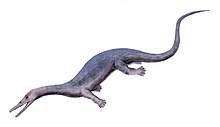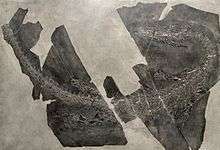Askeptosaurus
Askeptosaurus is an extinct genus of prehistoric marine reptiles in the order Thalattosauria. Their fossils have been found in the areas what are now Italy and Switzerland. It is believed to have lived in the Middle Triassic period, around 247 to 225 million years ago.[1]
| Askeptosaurus | |
|---|---|
 | |
| A cast of specimen MSNM V456 | |
| Scientific classification | |
| Kingdom: | Animalia |
| Phylum: | Chordata |
| Class: | Reptilia |
| Order: | †Thalattosauria |
| Family: | †Askeptosauridae |
| Genus: | †Askeptosaurus Nopcsa, 1925 |
| Species: | †A. italicus |
| Binomial name | |
| †Askeptosaurus italicus Nopcsa, 1925 | |
Description

Morphological analysis on its short limbs and the expanded zeugopodia suggested that the species was adapted to near-shore marine environment. Its webbed feet helped for steering through the water. Its slender body and long tail are believed to assist with aquatic locomotion. Judging from its elongated jaws and the many teeth-covered palate, its primary food source was fish.[2][3]
Typical features of thalattosaurs are the elongated premaxilla and the relatively large snout, and a small or absent upper temporal fenestra.[4] The cranial reconstruction of Askeptosaurus is consistent with the features previously listed: Askeptosaurus had a very slender and flattened skull. The snout was significantly elongated, the orbits were comparatively large, and the posterior skull table was deeply emarginated. The premaxilla of Askeptosaurus comprises almost half the length of the skull (maximum length is 26 cm (10.2 inches) among the investigated specimens) and forms more than one-third of the tooth row in the upper jaw.[3] Askeptosaurus also had the following traits differ from the non-askeptosauroid thalattosaurs:
1. Lack of a fusion between postorbital and postfrontal.
2. Presence of a homogenous dentition.
3. Absence of a diastema and palatal dentition.
4. Presence of low neural spines.
5. Presence of a slender radius.[3][5]

The vertebrae of Askeptosaurus were amphicoelous with no sign of pachyostosis. Based on observations, Askeptosaurus possessed at least 38 presacral vertebrae, two sacral vertebrae, and more than 60 caudal vertebrae. There is double-headed rib articulation in the cervical region and single-headed articulation in the dorsal area, which gave the estimated number of cervical vertebrae at least 13. Sacral and caudal ribs are all significantly shorter than the dorsal ribs and have holocephalous heads.[3]
Among known specimens, the maximum length of the femur is 13.8 cm (5.4 inches). The distal tarsals have different sizes. The largest element is distal tarsal 4. It articulates with metatarsals 4 and 5 distally, while the remaining distal tarsals meet their respective metatarsals.[3] The phalangeal formula of the pes is 2-3-4-4-4.
History of discovery
Askeptosaurus and its only known species Askeptosaurus italicus were first named and described in 1925 by Hungarian paleontologist Franz Nopcsa von Felső-Szilvás.[6]
The most recent research on A. italicus is done by Dr. Johannes Müller in 2005. He used the fossils preserved by MSNM (Museo di Scienze Naturali Milano, Italy) and PIMUZ (Paläontologisches Institut und Museum der Universität Zürich, Switzerland) to distinguish A. italicus from its sister taxa Anshunsaurus.
Classification
Prior to 2005, fossils of Askeptosaurus were rare and the position of Askeptosaurus on the phylogenetic tree had been a heated debate between different research teams. Recent analyses corroborate Renesto's (1992)[7] argument that Endennasaurus is more closely related to Askeptosaurus than to other thalattosaurs. It is now commonly agreed that a monophyletic group is formed by Anshunsaurus and Askeptosaurus. To be more specific, Askeptosaurus belongs to the family Askeptosauridae, a division of the suborder Askeptosauroidea. Within Askeptosauridae, Askeptosaurus is considered to be the sister taxon of Anshunsaurus, from Middle Triassic deposits in Guizhou, China.[8] At present, the Askeptosauroidea is only known from the Alpine Triassic and southern China, and Askeptosaurus represents the oldest record for this clade.
| Askeptosauroidea |
| |||||||||||||||||||||
Paleobiology
Askeptosaurus probably hunted in deep waters, because it had large eyes suited to conditions of low light. However, similar to ichthyosaurs it also had a protective bony ring around the eyes, which would have prevented them from collapsing under the immense water pressure of great depths.[2]
Paleoecology
A. italicus was distributed in the Middle and Upper Triassic of Switzerland (especially at Val Porina Monte San Giorgio [3]) and Italy with three other Thalattosauria genera: Clarazia, Hescheleria and Endennasaurus.
References
- http://fossilworks.org/bridge.pl?a=taxonInfo&taxon_no=36422
- Palmer, D., ed. (1999). The Marshall Illustrated Encyclopedia of Dinosaurs and Prehistoric Animals. London: Marshall Editions. p. 83. ISBN 978-1-84028-152-1.
- Müller, J., ed. (2005). The anatomy of Askeptosaurus italicus from the Middle Triassic of Monte San Giorgio and the interrelationships of thalattosaurs (Reptilia, Diapsida). Canada: Canadian Journal of Earth Science. pp. 1347–1367.
- Rieppel, Olivier; Müller, Johannes; Liu, Jun (2005). "Rostral structure in Thalattosauria (Reptilia, Diapsida)". Canadian Journal of Earth Sciences. 42 (12): 2081–2086. doi:10.1139/e05-076.
- Cheng, L. (2011). "New Study of Anshunsaurus huangnihensis Cheng, 2007 (Reptilia: Thalattosauria): Revealing its Transitional Position in Askeptosauridae". Journal of the Geological Society of China. 85 (6): 1231–1237. doi:10.1111/j.1755-6724.2011.00584.x.
- Nopcsa, F, ed. (1925). Askeptosaurus, ein neues reptil der Trias von Besano: Centralblatt für Mineralogie, Geologie und Paläontologie. pp. 265–2.
- Renesto, S. (1992). "The anatomy and relationships of Endennasaurus acutirostris (Reptilia, Neodiapsida) from the Norian (Late Triassic) of Lombardy". Rivista Italiana di Paleontologia e Stratigrafia. 97: 409–430.
- Liu, J. (1999). "Sauropterygian from Triassic of Guizhou, China". Chinese Science Bulletin. 44 (14): 1312–1316. doi:10.1007/BF02885852.